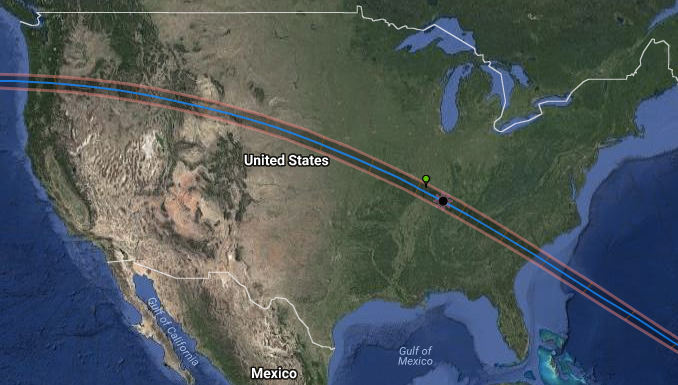Solar eclipse TV channels, live streaming Eclipse: Watch Monday’s eclipse live, onilne
Published 5:19 pm Sunday, August 20, 2017

- The Total Solar Eclipse 2017 is August 21 in the United States.
Are you ready for some blackout?
It’s time for the Total Solar Eclipse 2017.
Get your goggles, on, baby.
Millions of Americans converged on a narrow corridor stretching from Oregon to South Carolina to watch the moon blot out the midday sun Monday for a wondrous couple of minutes in the first total solar eclipse to sweep coast to coast in 99 years.
Millions of Americans converged on a narrow corridor stretching from Oregon to South Carolina to watch the moon blot out the midday sun Monday for a wondrous couple of minutes in the first total solar eclipse to sweep coast to coast in 99 years.
Veteran eclipse watchers warned the uninitiated to get ready to be blown away.
Planetariums and museums posted “Sold out of eclipse glasses” on their front doors. Signs along highways reminded motorists of “Solar Eclipse Monday,” while cars bore the message “Eclipse or bust.”
With 200 million people within a day’s drive of the path of totality, towns and parks braced for monumental crowds. It’s expected to be the most observed, most studied and most photographed eclipse ever. Not to mention the most festive, what with all the parties.
For those not in the 14 states comprising the eclipse’s “path of totality,” here’s a look at some of the viewing opportunities online and on TV:
— “Eclipse of the Century “: In partnership with Volvo, CNN plans two hours of livestreaming, 360-degree coverage accessible in virtual reality through Oculus and other VR headsets beginning at 1 p.m. EDT. Accompanying television coverage will include reporting from Oregon, Missouri, Tennessee and South Carolina.
— “Eclipse Over America “: The PBS science series NOVA is planning a quick turnaround on its eclipsedocumentary premiering Monday. Senior executive producer Paula S. Apsell said “Eclipse Over America,” which delves into why eclipses occur and what scientists can learn from them, will incorporate images of the event from across the country shot earlier that day with Dantowitz’s high-tech cameras.
— “Great American Eclipse “: The Science Channel will broadcast its live coverage from Madras, Oregon, from noon to 4 p.m. EDT, with commentary from educators and astronomers from the Lowell Observatory.
— “The Great American Eclipse “: David Muir will anchor ABC’s two hours of live coverage, with correspondents reporting from viewing parties across the country. NBC also plans live coverage, with Lester Holt hosting special reports at 1 and 2 p.m. EDT featuring correspondents reporting from Oregon, Illinois, Wyoming and South Carolina. Shepard Smith will break into typical broadcasting on Fox News Channel from noon to 4 p.m. EDT to update viewers on the eclipse and introduce footage from NASA and observatories around the country.
— “Solar Eclipse: Through the Eyes of NASA “: NASA will offer hours of coverage online and on NASA Television beginning at noon Eastern. It plans livestreaming of the eclipse beginning at 1 p.m. EDT with images from satellites, research aircraft, high-altitude balloons and specially modified telescopes.
— “The Total Solar Eclipse”: The Weather Channel is kicking off its live coverage at 6 a.m. EDT and continuing throughout the day with dispatches from seven locations along the “path of totality.”
In Salem, Oregon, a field outside the state fairgrounds was transformed into a campground in advance of an eclipse-watching party for 8,500.
“It’s one of those ‘check the box’ kind of things in life,” said Hilary O’Hollaren, who drove 30 miles from Portland with her two teenagers and a tent, plus a couple friends.
Astronomers consider a full solar eclipse the grandest of cosmic spectacles.
The Earth, moon and sun line up perfectly every one to three years, briefly turning day into night for a sliver of the planet. But these sights normally are in no man’s land, like the vast Pacific or the poles. This will be the first eclipse of the social media era to pass through such a heavily populated area.
The moon hasn’t thrown this much shade at the U.S. since 1918. That was the country’s last coast-to-coast total eclipse.
In fact, the U.S. mainland hasn’t seen a total solar eclipse since 1979 — and even then, only five states in the Northwest experienced total darkness before the eclipse veered in Canada.
Monday’s total eclipse will cast a shadow that will race through 14 states, entering near Lincoln City, Oregon, at 1:16 p.m. EDT, moving diagonally across the heartland and then exiting near Charleston, South Carolina, at 2:47 p.m. EDT. The path will cut 2,600 miles (4,200 kilometers) across the land and will be just 60 to 70 miles (96 kilometers to 113 kilometers) wide.
Mostly clear skies beckoned along much of the route, according to the National Weather Service .
Shawnee National Forest in southern Illinois will see the longest stretch of darkness: 2 minutes and 44 seconds.
All of North America will get at least a partial eclipse. Central America and the top of South America will also see the moon cover part of the sun.
NASA and other scientists will be watching and analyzing from telescopes the ground and in orbit, the International Space Station, airplanes and scores of high-altitude balloons, which will beam back live video. Citizen scientists will monitor animal and plant behavior as daylight turns into twilight and the temperature drops.
NASA’s associate administrator for science missions, Thomas Zurbuchen, took to the skies for a dry run Sunday. He will usher in the eclipse over the Pacific Coast from a NASA plane.
“Can’t wait for the cosmic moment Mon morning,” he tweeted.
Near Victoria, British Columbia, where 91 percent of the sun will be eclipsed, science and math teacher Clayton Uyeda is planning to watch from a ferry along with his wife. He said he is “expecting to have a real sense of connection with the heavens.”
He has similarly lofty hopes for his students if they can bring themselves to look up at the sky instead of down at their electronic devices.
Scientists everywhere agree with Uyeda: Put the phones and cameras down and enjoy the greatest natural show on Earth with your own (protected) eyes.
The only time it’s safe to look directly without protective eyewear is during totality, when the sun is 100 percent covered. Otherwise, keep the solar specs on or use pinhole projectors that can cast an image of the eclipse into a box.
The next total solar eclipse in the U.S. will be in 2024. The next coast-to-coast one will not be until 2045.





